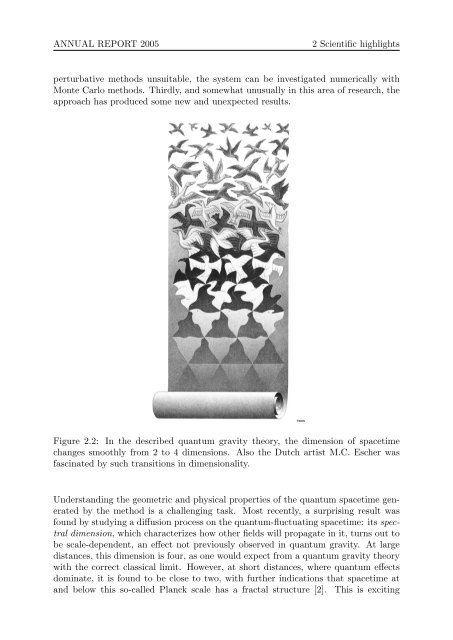- Page 1: ANNUAL REPORT 2005Dutch Research Sc
- Page 4 and 5: ANNUAL REPORT 2005Preface
- Page 6 and 7: ANNUAL REPORT 2005Contents6 Scienti
- Page 8 and 9: ANNUAL REPORT 2005 1 The DRSTP in 2
- Page 10 and 11: ANNUAL REPORT 2005 1 The DRSTP in 2
- Page 12 and 13: ANNUAL REPORT 20052 Scientific high
- Page 16 and 17: ANNUAL REPORT 20052 Scientific high
- Page 18 and 19: ANNUAL REPORT 20053 PhD programmeE.
- Page 20 and 21: ANNUAL REPORT 20053 PhD programmeti
- Page 22: ANNUAL REPORT 20053 PhD programmepa
- Page 26 and 27: ANNUAL REPORT 20053 PhD programmeat
- Page 28 and 29: ANNUAL REPORT 20053 PhD programmean
- Page 30 and 31: ANNUAL REPORT 20053 PhD programmeYa
- Page 32: ANNUAL REPORT 20053 PhD programmean
- Page 35 and 36: ANNUAL REPORT 20053 PhD programmead
- Page 37 and 38: ANNUAL REPORT 20053 PhD programme
- Page 39 and 40: ANNUAL REPORT 20053 PhD programme
- Page 41 and 42: ANNUAL REPORT 20053 PhD programme
- Page 43 and 44: ANNUAL REPORT 20053 PhD programme-
- Page 45 and 46: ANNUAL REPORT 20053 PhD programme-
- Page 47 and 48: ANNUAL REPORT 20053 PhD programmeSa
- Page 49 and 50: ANNUAL REPORT 20053 PhD programme-
- Page 51 and 52: ANNUAL REPORT 20053 PhD programme-
- Page 54 and 55: ANNUAL REPORT 20053 PhD programme-
- Page 56 and 57: ANNUAL REPORT 20053 PhD programme
- Page 58 and 59: ANNUAL REPORT 2005 4 Scientific sta
- Page 60 and 61: ANNUAL REPORT 2005 4 Scientific sta
- Page 62 and 63: ANNUAL REPORT 2005 4 Scientific sta
- Page 64 and 65:
ANNUAL REPORT 20055 Academic public
- Page 66 and 67:
ANNUAL REPORT 20055 Academic public
- Page 68 and 69:
ANNUAL REPORT 20055 Academic public
- Page 70 and 71:
ANNUAL REPORT 20055 Academic public
- Page 72 and 73:
ANNUAL REPORT 20055 Academic public
- Page 74 and 75:
ANNUAL REPORT 20055 Academic public
- Page 76 and 77:
ANNUAL REPORT 20055 Academic public
- Page 78 and 79:
ANNUAL REPORT 20055 Academic public
- Page 80 and 81:
ANNUAL REPORT 20055 Academic public
- Page 82 and 83:
ANNUAL REPORT 20056 Scientific acti
- Page 84 and 85:
ANNUAL REPORT 20056 Scientific acti
- Page 86 and 87:
ANNUAL REPORT 20056 Scientific acti
- Page 88 and 89:
ANNUAL REPORT 20056 Scientific acti
- Page 90 and 91:
ANNUAL REPORT 20056 Scientific acti
- Page 92 and 93:
ANNUAL REPORT 20056 Scientific acti
- Page 94 and 95:
ANNUAL REPORT 20056 Scientific acti
- Page 96 and 97:
ANNUAL REPORT 20056 Scientific acti
- Page 98 and 99:
ANNUAL REPORT 20056 Scientific acti
- Page 100 and 101:
ANNUAL REPORT 20056 Scientific acti
- Page 102 and 103:
ANNUAL REPORT 20056 Scientific acti
- Page 104 and 105:
ANNUAL REPORT 20056 Scientific acti
- Page 106 and 107:
ANNUAL REPORT 20056 Scientific acti
- Page 108 and 109:
ANNUAL REPORT 20056 Scientific acti
- Page 110 and 111:
ANNUAL REPORT 20056 Scientific acti
- Page 112 and 113:
ANNUAL REPORT 20057 Science-related
- Page 114 and 115:
ANNUAL REPORT 20057 Science-related
- Page 116 and 117:
ANNUAL REPORT 20057 Science-related
- Page 118 and 119:
ANNUAL REPORT 20057 Science-related
- Page 120 and 121:
ANNUAL REPORT 20058 Research fundin
- Page 122 and 123:
ANNUAL REPORT 20058 Research fundin
- Page 124 and 125:
ANNUAL REPORT 20058 Research fundin
- Page 126 and 127:
ANNUAL REPORT 20058 Research fundin
- Page 128 and 129:
ANNUAL REPORT 20058 Research fundin
- Page 130 and 131:
ANNUAL REPORT 2005 9 Organisation D
- Page 132 and 133:
ANNUAL REPORT 200510 AddressesP.O.
- Page 134 and 135:
ANNUAL REPORT 200510 AddressesMater
- Page 136 and 137:
ANNUAL REPORT 2005Appendix Aassiste
- Page 138 and 139:
ANNUAL REPORT 2005Appendix A
- Page 140 and 141:
ANNUAL REPORT 2005Appendix B
- Page 142 and 143:
ANNUAL REPORT 2005Appendix CCompre,
- Page 144 and 145:
ANNUAL REPORT 2005Appendix CStudent
- Page 146 and 147:
ANNUAL REPORT 2005Appendix DPartici
- Page 148 and 149:
ANNUAL REPORT 2005Appendix DSanchez
- Page 150 and 151:
ANNUAL REPORT 2005Appendix EPhD eff
















